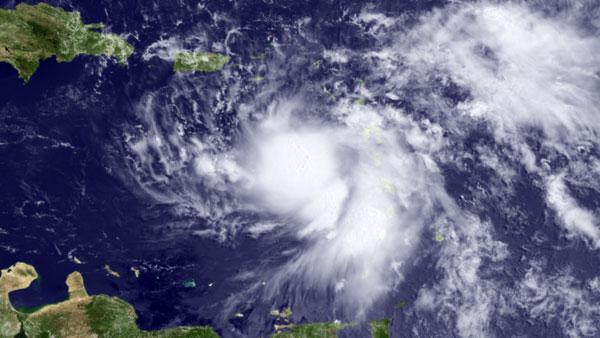
When Will The Next Hurricane Hit the US?

A hurricane has not hit the United States in nearly three years. Could the newly formed Tropical Storm Emily break the lull?
Probably not, according to the forecast from the National Hurricane Center (NHC). Tropical Storm Emily has only a 23 percent chance of strengthening to a Category 1 hurricane by Monday (Aug. 8), when the storm will be moving along the East Coast, according to the NHC's Dennis Feltgen.
Emily is about 145 miles (230 kilometers) south-southwest of Santo Domingo, Dominican Republic. The storm is moving westward at 14 mph (22 kph) with winds of up to 50 mph (85 kph). The central Bahamas is currently under a tropical storm watch, and tropical storm warnings are in effect for Cuba, Puerto Rico, the Dominican Republic and Haiti. [Related: Which U.S. Cities Are Most Vulnerable to Hurricanes?]
Hurricane hazard?
Emily would need to strengthen to have winds of at least 74 mph (119 kph) to become the first hurricane of the 2011 Atlantic hurricane season . So far, five tropical storms (Arlene, Bret, Cindy, Don and now Emily) and no hurricanes have formed in the Atlantic basin. But typically the most active part of the season comes in August and September. The last time the first five named Atlantic storms all stayed at tropical storm strength was 2006.
The last hurricane to hit the United States was Hurricane Ike in September 2008. That storm socked the coasts of Texas and Louisiana, killing dozens of people. The lull since then is the longest since the 3-year gap between Hurricane Irene in October 1999 and Hurricane Lili in October 2002. If no hurricanes hit the United States this year, it would be the longest lull between U.S. hurricane landfalls in recorded history, according to data from the National Oceanic and Atmospheric Administration (NOAA).
"It would be the longest [gap in landfalls] since at least the Civil War," said Colorado State University forecaster Phil Klotzbach.
Sign up for the Live Science daily newsletter now
Get the world’s most fascinating discoveries delivered straight to your inbox.
Drought buster
Klotzbach doesn't expect that to happen. According to his team's updated forecast released today (Aug. 3), the 2011 hurricane season has a 70 percent chance of producing a hurricane that would make landfall somewhere along the U.S. coast. The forecast does not make any specific predictions about hurricane landfall, which is driven by where the storms form and the overriding weather patterns at the time the storm approaches land.
"When they form very far east, the odds of them making landfall in the U.S. is very little," Klotzbach told OurAmazingPlanet.
So when in the season a storm might strike the United States is anybody's guess.
The 2011 season, which runs from June 1 to Nov. 30, is expected to be a doozy, according to NOAA. The forecast predicts between six to 10 hurricanes, three to six major hurricanes (those with winds of up to 111 mph (179 kph) or higher) and 12 to 18 named storms (tropical storms and hurricanes receive names).
The 2010 season was one of the busiest ever, with 12 hurricanes in the Atlantic the second-highest number on record, tied with 1969 and 19 named storms, a tie with 1887 and 1995 as the third-busiest season on record. An average Atlantic season produces 11 named storms, six hurricanes and two major hurricanes. The busiest season on record remains 2005, which saw 28 named storms, including Hurricane Katrina .
- History of Destruction: 8 Great Hurricanes
- In the Eye of the Storm: NASA's Hurricane Hunters
- Natural Disasters: Top 10 U.S. Threats
Email OurAmazingPlanet staff writer Brett Israel at bisrael@techmedianetwork.com. Follow him on Twitter @btisrael.










